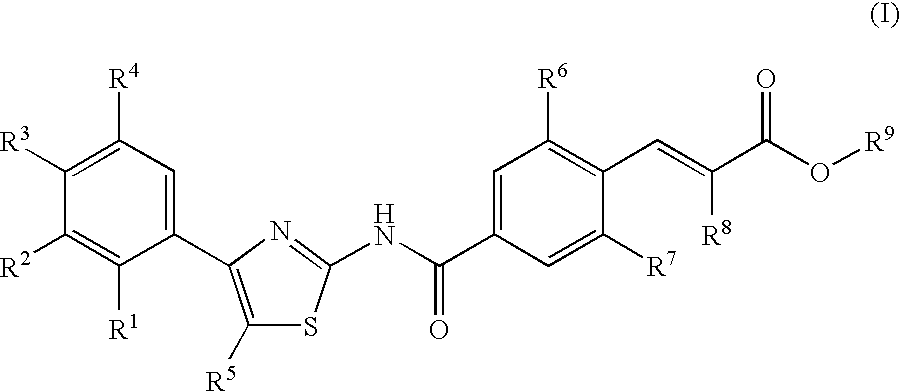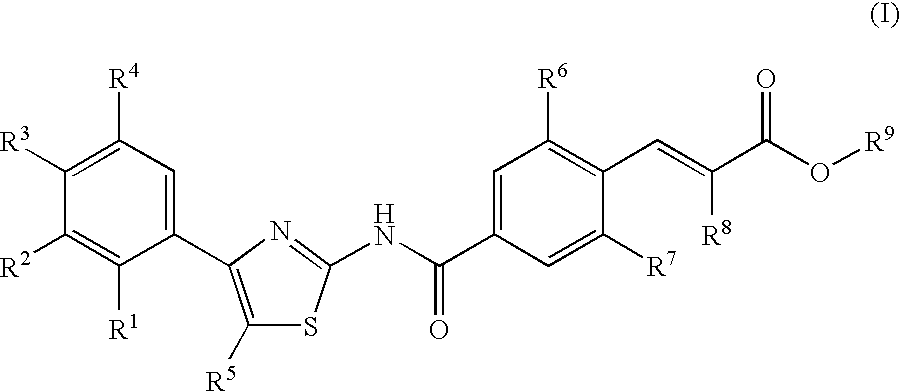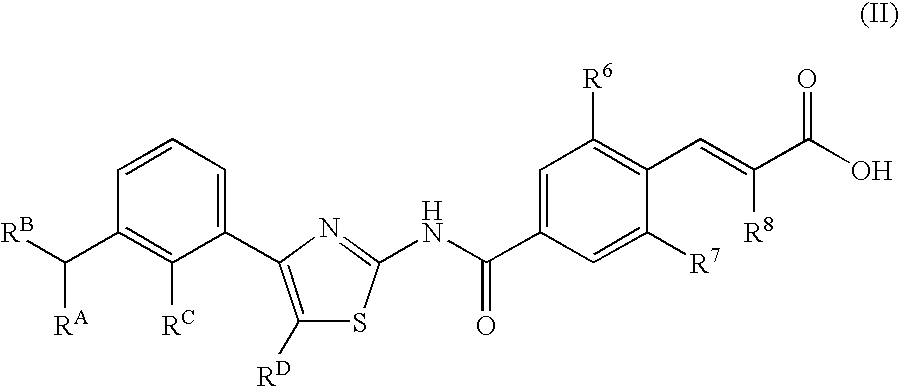Compounds exhibiting thrombopoietin receptor agonism
a technology of thrombopoietin and agonism, which is applied in the field of compounds exhibiting thrombopoietin receptor agonism, can solve the problems that peptide derivatives are not generally practical for oral administration, and achieve the effect of reducing the ratio of platelet number decrease, and increasing the number of platelet number
- Summary
- Abstract
- Description
- Claims
- Application Information
AI Technical Summary
Benefits of technology
Problems solved by technology
Method used
Image
Examples
example 1
Synthesis of Compound (A1)
[0192]
1) Synethesis of 4-bromo-2,6-difluorobenzaldehyde (2)
[0193]To a THF (250 mL) solution of diisopropylamine (53 mL) was added 2.44 M hexane solution of butyl lithium at −78° C., and the reaction mixture was stirred for 30 miniute. To the reaction mixture was added a THF solution of 3,5-difluorobromobenzene (1) (36 g), and then the reaction mixture was stirred for 1 h. To the reaction mixture was added DMF 146 mL, and the reaction mixture was stirred for additional 1 h. To the reaction mixture was added a saturated ammonium chloride aqueous solution, and the reaction mixture was extracted with ethyl acetate. The organic layer was washed with water, and brine, dried over magnesium sulfate, and evaporated. The obtained residue was purified by column chromatography (hexane:ethyl acetate=20:1) to obtain the compoumd (2) 23.2 g.
[0194]1H-NMR(CDCl3) 10.29(s, 1H), 7.19-7.25(m, 2H).
2) Synthesis of ethyl 3-(4-bromo-2,6-difluorophenyl)-2-methylacrylate (3)
[0195]To ...
example 2
Synthesis of Compound (A1307)
[0207]
1) Synthesis of tert-butyl 3-(2-isopropylphenoxy)propionate (10)
[0208]2-Isopropylphenol (6 g) was dissolved in acrylic acid tert-butyl ester (6.2 g), and to the mixture was added potassium tert-butyloxide (0.3 g). The reaction mixture was stirred at 130° C. for 6 h. To the reaction mixture was added water, the reaction mixture extracted with ethyl acetate. The organic layer was washed with brine, dried over magnesium sulfate, and evaporated. The obtained residue was purified by column chromatography (hexane:ethyl acetate=9:1) to obtain the compound (10) 4.3 g.
[0209]1H-NMR(CDCl3) 7.20(dd, 1H, J=7.5, 1.7 Hz), 7.14(dt, 1H, J=7.5, 1.7Hz), 6.92(dd, 1H, J=7.5, 1.7 Hz), 6.86(dt, 1H, J=7.5, 1.7 Hz), 4.21(t, 2H, J=6.3 Hz), 3.30(sext, 1H, J=7.0 Hz), 2.72(t, 2H, J=6.3 Hz), 1.45(s, 9H), 1.15(d, 6H, J=7.0 Hz).
2) Synthesis of 3-(2-isopropylphenoxy)propionic acid (11)
[0210]3-(2-Isopropylphenoxy)propionic acid tert-butyl ester (10) (4.3 g) was dissolved in dichlor...
example 3
Synthesis of 3-[2,6-difluoro-4-(4,5-dihydro-6-pentylnaphtho[1,2-d]thiazol-2-ylcabamoyl)phenyl]-2-methylacrylic acid (A2)
[0221]1H-NMR(DMSO-d6) 12.92(bs, 2H), 7.91-7.98(m, 2H), 7.62-7.65(m, 1H), 7.33(s, 1H), 7.18-7.23(m, 1H), 7.06-7.10(m, 1H), 2.97(s, 4H), 2.63(t, 2H, J=7.6 Hz), 1.80(s, 3H), 1.52(t, 2H, J=6.9 Hz), 1.32-1.35(m, 4H), 0.88(t, 3H, J=6.0 Hz).
PUM
| Property | Measurement | Unit |
|---|---|---|
| temperature | aaaaa | aaaaa |
| temperature | aaaaa | aaaaa |
| RA | aaaaa | aaaaa |
Abstract
Description
Claims
Application Information
 Login to View More
Login to View More - R&D
- Intellectual Property
- Life Sciences
- Materials
- Tech Scout
- Unparalleled Data Quality
- Higher Quality Content
- 60% Fewer Hallucinations
Browse by: Latest US Patents, China's latest patents, Technical Efficacy Thesaurus, Application Domain, Technology Topic, Popular Technical Reports.
© 2025 PatSnap. All rights reserved.Legal|Privacy policy|Modern Slavery Act Transparency Statement|Sitemap|About US| Contact US: help@patsnap.com



